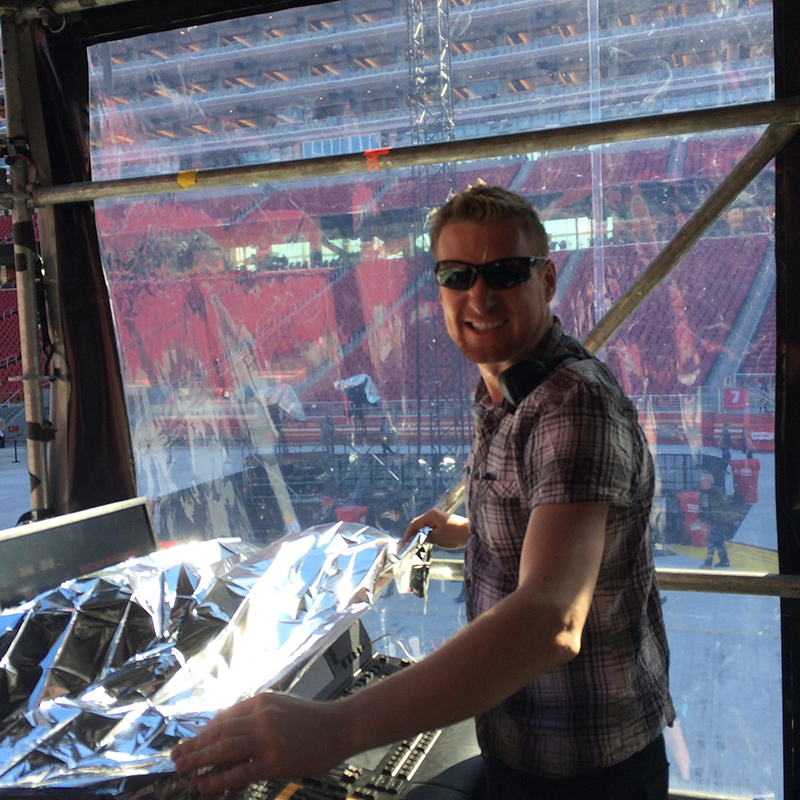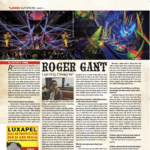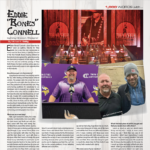Alex Murphy started out in theater, but a fateful conversation about his involvement with lighting the exterior of the National Theatre on the South Bank of the Thames would turn into a position as lighting associate on U2’s epic 360˚ tour. He has been lighting director/programmer for all the U2 tours since then, including the current U2 eXPERIENCE + iNNOCENCE tour. Aside from U2, his other credits include Robbie Williams’ Take the Crown tour; the U.K. arena tour of Strictly Come Dancing Live; PJ Harvey, Grace Jones, Walking with Dino and Macy Gray amongst others; and Nick Gray’s UK-based creative visual design firm Renegade on fashion shows. Murphy has also returned to his roots working with Williams on theater projects including French & Saunders: Still Alive and Steve Coogan Live: As Alan Partridge and Other Less Successful Characters. PLSN caught up with Murphy between the U.S. and European legs of the current U2 tour.
PLSN: How did you get into lighting?
Alex Murphy: I was very lucky to be accepted into Rose Bruford [College of Theatre & Performance] which, at the time, was the only course in the U.K. that specialized in lighting design. It was absolutely fantastic. We had some really good lectures, and we were allowed to fail quite a lot, which was quite important. When I graduated, I went to work for White Light. Which I thoroughly encourage. I always give people advice — not just to work for White Light — but I think everybody should work for a rental shop or a warehouse, because it’s where you learn, where you see a lot of things happening, and you meet a lot of people. And from there, I went to the National Theatre. I went over for one day to fix some light curtains, and eight years later I was still there. I started as a lighting guy at the Olivier. And then for my last three years, I was the lighting resources manager, so I was technically the mini-hire company within the building. It was a busy and fun time.
How did you get into concert touring?
I had gone for an awards dinner, and I bumped into a gentleman called Willie Williams. We got talking, as I was responsible for the exterior lighting at the National Theatre and he was about to embark on an exterior lighting project on another building on the South Bank. He asked me if I’d like to help him with it. It was the right time for me to leave the National and he took a chance on me, so I went to do 360˚ with him. I called the followspots on the tour. That was my first big tour. I’d been doing lots of small shows, but I hadn’t been out on such a long, large tour like that at all. Talk about jumping in at the deep end!

What do you think is an essential element needed in the lighting director, lighting designer relationship?
I’ve been very lucky over the years to spend most of my time working with Willie Williams. Our relationship is fantastic, but the main idea of the game is to take the designer’s vision, turn it into a load of numbers in a desk then make sure that that scenario plays back with great constancy night after night. I think it’s great to be able to know when to take the ball and run with a certain song or take a back seat and simply punch the buttons. This year I’ve also been working with PJ Harvey, with Adam Silverman as the designer. If you’ve not worked with someone before it can be a bit touch and go. Don’t forget they’re relying on you to be the conduit from their design to the technical team and to work at their pace. It’s a great feeling in the first few hours of day one to know that you’re going to produce some great stuff; that was the case with Adam.
What are some memorable experiences you’ve had in your career?
I mean, completing 360˚ was just amazing. After 30 all-nighters in that huge stadium in complete darkness with just me, Willie, Ethan [Weber] and one generator guy, I just remember the very first show day, standing in that stadium with 90,000 people screaming and thinking “Okay, we’d better do a show tonight.” I was so nervous that night.
Working with the icon that is Grace Jones stands out. She is an amazing artist to work with. She knows exactly what she wants from a production, if she doesn’t get it well you certainly know about it. No artist has terrified me and praised me for my work on a single day. Grace on stage, standing on a revolve with a mirror ball top hat on with us firing lasers at the hat was always a roller coaster of a song I can tell you.
Also, I’ve been very lucky over the years to be asked to work as the designer for HIFA arts festival in Harare, Zimbabwe. It’s one of the craziest and most fantastic festivals I’ve ever done. The acts are from all over the world for a one-week festival in the country’s capitol. It’s a week of fuel shortage for the generator, government intimidation, laughter and overnight lighting sessions. Every night, we’re wondering if we’ll get to the end of the show and still have lighting as we get down to less then two liters of fuel left. I’d have to thank the U.K. companies that have donated equipment over the years, and also the British crew I’ve press-ganged into coming to work on it. Nothing else is like it, and I can tell you, some terrifyingly large insects fly towards the followspots on that gig!

What do you enjoy most about your career?
It has to be the audiences’ reaction. I mean, on the Joshua Tree tour, the moment where that huge screen came on and they started to play “Where the Streets Have No Name.” Every night it would make the hair stand up on the back of my neck, and then you see the entire audience just freaking out. It’s important to remind yourself about those kinds of moments when it’s two o’clock in the morning, pissing down rain, and you’re still waiting for the front of house truck to arrive so you can put consoles on.
What do you like least about your job?
I think I would say it’s the hours. The hours that we do are crazy — we finish load outs at 2 a.m., and we then leave in four hours to go to another gig. The early mornings, and the very late nights, that’s what I don’t like about the industry. And also, if festivals could stop putting all their wash lights in 150,000 channel mode, that would be fantastic. It’s crazy when you turn on a wash light and get one LED in the middle of this 30-LED fixture.
Who have some of your mentors been?
I was very lucky while at the National; I sat through countless lighting sessions and tech sessions with different lighting designers, so I learnt a lot about shadow and contrast from people like Paule Constable, Mark Henderson and Neil Austin. And clearly working with Willie is just fantastic, and above all, we laugh a lot. Really, that’s important, when you are working crazy hours and spend so much time travelling and working with people, you have to remember to laugh and have fun.
Pictured, top: Murphy discovers a vintage Strand Light Organ.


